FRUIT TREES
APPLES
 Arkansas Black Spur Large dark red skinned apple. High quality fruit for dessert and cooking. Lasts for several months after harvest. Self fruitful tree, however it will benefit from another pollinator such as Golden Delicious. Semi-Dwarf tree that grows ten to thirteen feet tall. Late season harvest. Hardy in Zones 5 to 9.
Arkansas Black Spur Large dark red skinned apple. High quality fruit for dessert and cooking. Lasts for several months after harvest. Self fruitful tree, however it will benefit from another pollinator such as Golden Delicious. Semi-Dwarf tree that grows ten to thirteen feet tall. Late season harvest. Hardy in Zones 5 to 9.
 Honeycrisp Cold hardy tree from the University of Minnesota. Red stripes over yellow high quality fruit. Aromatic fruit is crisp and juicy. Excellent for fresh eating. Apples store well after harvest. Pollinated best by Red Delicious, Granny Smith, Gala, or McIntosh. Hardy in Zones 3 to 8. Mid Season harvest
Honeycrisp Cold hardy tree from the University of Minnesota. Red stripes over yellow high quality fruit. Aromatic fruit is crisp and juicy. Excellent for fresh eating. Apples store well after harvest. Pollinated best by Red Delicious, Granny Smith, Gala, or McIntosh. Hardy in Zones 3 to 8. Mid Season harvest
 Granny Smith Large green apple with crisp tart flavor. Great all purpose apple that has excellent shelf life after harvest. Thrives in hot areas where other apples struggle. Self pollinating and excellent pollinator for most other apples. Hardy in zones 5b-9. Late season harvest.
Granny Smith Large green apple with crisp tart flavor. Great all purpose apple that has excellent shelf life after harvest. Thrives in hot areas where other apples struggle. Self pollinating and excellent pollinator for most other apples. Hardy in zones 5b-9. Late season harvest.
 Jonathan High quality medium to dark red fruit. Great for cooking. Tart, crisp and juicy with good flavor. Consistently produces heavy crops when pruned and fertilized regularly. Self pollinating. Hardy in zones 4 to 8. Mid season harvest.
Jonathan High quality medium to dark red fruit. Great for cooking. Tart, crisp and juicy with good flavor. Consistently produces heavy crops when pruned and fertilized regularly. Self pollinating. Hardy in zones 4 to 8. Mid season harvest.
 Pink Lady Reddish-pink fruit. Very crisp, sweet-tart distinct flavor. Great shelf life after harvest. Self pollinating. Hardy in zones 6 to 9. Late season harvest.
Pink Lady Reddish-pink fruit. Very crisp, sweet-tart distinct flavor. Great shelf life after harvest. Self pollinating. Hardy in zones 6 to 9. Late season harvest.
 Red Delicious Dark red fruit. Sweet, crisp and fine-flavored. Vigorous and very productive. Good pollinizer for almost all other apples. Hardy in zones 5 to 8. Mid season harvest.
Red Delicious Dark red fruit. Sweet, crisp and fine-flavored. Vigorous and very productive. Good pollinizer for almost all other apples. Hardy in zones 5 to 8. Mid season harvest.
 Golden Delicious Long time favorite for its sweetness and flavor. Reliable producer, adaptable to many climates. Self pollinating, and great pollinizer for Red Delicious. Hardy in zones 5 to 10. Mid season harvest.
Golden Delicious Long time favorite for its sweetness and flavor. Reliable producer, adaptable to many climates. Self pollinating, and great pollinizer for Red Delicious. Hardy in zones 5 to 10. Mid season harvest.
 Winesap Juicy, smooth texture with lively flavor. Great used either fresh or cooked. Pollinized by Red or Golden Delicious, Fuji, Gala or Liberty. Hardy in zones 5 to 8. Mid season harvest.
Winesap Juicy, smooth texture with lively flavor. Great used either fresh or cooked. Pollinized by Red or Golden Delicious, Fuji, Gala or Liberty. Hardy in zones 5 to 8. Mid season harvest.
APRICOT
 Blenheim All-purpose freestone, sweet, aromatic and flavorful. Early bloom and late June/early July harvest. Self pollinating. Hardy in zones 5 to 9
Blenheim All-purpose freestone, sweet, aromatic and flavorful. Early bloom and late June/early July harvest. Self pollinating. Hardy in zones 5 to 9
 Chinese Cold hardy, frost hardy, sets heavy crops of small to medium size sweet fruit. Recommended for difficult, spring frost-prone climates. Self pollinating. Hardy in zones 4 to 7
Chinese Cold hardy, frost hardy, sets heavy crops of small to medium size sweet fruit. Recommended for difficult, spring frost-prone climates. Self pollinating. Hardy in zones 4 to 7
 Moorpark Long time favorite of apricot fanciers for its exceptionally rich flavor and aroma. Very reliable producer. Used fresh and for canning. Self pollinating. Hardy in zones 5 to 9
Moorpark Long time favorite of apricot fanciers for its exceptionally rich flavor and aroma. Very reliable producer. Used fresh and for canning. Self pollinating. Hardy in zones 5 to 9
CHERRY
 Bing Large, firm, juicy, sweet, nearly black when ripe – superb flavor. Large vigorous tree. Pollinized by Black Tart, Rainier and Lapins. Hardy in zones 5 to 9.
Bing Large, firm, juicy, sweet, nearly black when ripe – superb flavor. Large vigorous tree. Pollinized by Black Tart, Rainier and Lapins. Hardy in zones 5 to 9.
 Black Tartarian Medium-sized, nearly black, sprightly flavor. Vigorous, productive tree. Requires pollination; interfruitful with all popular sweet cherries. Hardy in zones 5 to 7.
Black Tartarian Medium-sized, nearly black, sprightly flavor. Vigorous, productive tree. Requires pollination; interfruitful with all popular sweet cherries. Hardy in zones 5 to 7.
 Rainier Large yellow with red blush. Sweet and flavorful. Very cold hardy. Pollenized by Van, Lambert, Lapins, Black Tartarian and Bing. Hardy in zones 5 to 9.
Rainier Large yellow with red blush. Sweet and flavorful. Very cold hardy. Pollenized by Van, Lambert, Lapins, Black Tartarian and Bing. Hardy in zones 5 to 9.
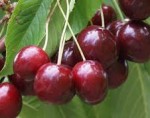 Stella Large, nearly black, richly flavored sweet cherry. Self pollinating. Hardy in zones 5 to 9.
Stella Large, nearly black, richly flavored sweet cherry. Self pollinating. Hardy in zones 5 to 9.
PEACH
 Elberta Famous yellow freestone. Classic, rich, peach flavor. Use fresh, canned or cooked. Self pollinating. Mid season harvest.
Elberta Famous yellow freestone. Classic, rich, peach flavor. Use fresh, canned or cooked. Self pollinating. Mid season harvest.
 Belle of Georgia Reliable, old-time white peach with red blush. Firm freestone flesh tinged red. High flavored for fresh eating or canning. Resists bacterial spot. Self pollinating. Mid season harvest.
Belle of Georgia Reliable, old-time white peach with red blush. Firm freestone flesh tinged red. High flavored for fresh eating or canning. Resists bacterial spot. Self pollinating. Mid season harvest.
 Ranger Medium sized, full-flavored, high quality yellow freestone. Late blooming and frost hardy. Self pollinating. Mid season harvest.
Ranger Medium sized, full-flavored, high quality yellow freestone. Late blooming and frost hardy. Self pollinating. Mid season harvest.
 Majestic Enormous size freestone fruit. Classic peachy/orange with a juicy yellow interior. Self pollinating. Mid season harvest.
Majestic Enormous size freestone fruit. Classic peachy/orange with a juicy yellow interior. Self pollinating. Mid season harvest.
 Red Haven High quality freestone fruit. This is the worlds most widely planted peach. Frost hardy. Self pollinating. Mid season harvest.
Red Haven High quality freestone fruit. This is the worlds most widely planted peach. Frost hardy. Self pollinating. Mid season harvest.
 Reliance Sweet, flavorful yellow freestone. Best choice for climates having severe cold in winter and spring. Self pollinating. Mid season harvest.
Reliance Sweet, flavorful yellow freestone. Best choice for climates having severe cold in winter and spring. Self pollinating. Mid season harvest.
 Bonanza Miniature Unique minature tree that is perfect for small areas. Large yellow freestone, sweet, low in acid, mild refreshing flavor. Self pollinating. Mid season harvest.
Bonanza Miniature Unique minature tree that is perfect for small areas. Large yellow freestone, sweet, low in acid, mild refreshing flavor. Self pollinating. Mid season harvest.
PEAR
 Warren Excellent quality dessert pear. Cold hardy and highly resistant to blight. Medium to large,smooth, long-necked fruit with pale green skin, sometimes blushed red. Self pollinating.
Warren Excellent quality dessert pear. Cold hardy and highly resistant to blight. Medium to large,smooth, long-necked fruit with pale green skin, sometimes blushed red. Self pollinating.
 Kieffer Medium to large late season fruit. Primarily used for canning/cooking. Sprightly flavor, course texture. Resists fire blight. Self pollinating.
Kieffer Medium to large late season fruit. Primarily used for canning/cooking. Sprightly flavor, course texture. Resists fire blight. Self pollinating.
 Perdue Large fruit with a smooth, slightly-blotched skin that is greenish to greenish/yellow in color. Flesh is white, juicy, sweet, and very flavorful. Self pollinating.
Perdue Large fruit with a smooth, slightly-blotched skin that is greenish to greenish/yellow in color. Flesh is white, juicy, sweet, and very flavorful. Self pollinating.
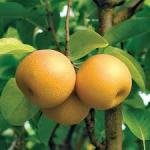 Korean Giant Asian Pear Globe-shaped fruit, which ripen to golden brown in early fall, can weigh more than a pound. The flesh is very crisp, juicy, and sweet, with a mildly spicy edge. Requires cross pollination from another Asian Pear variety.
Korean Giant Asian Pear Globe-shaped fruit, which ripen to golden brown in early fall, can weigh more than a pound. The flesh is very crisp, juicy, and sweet, with a mildly spicy edge. Requires cross pollination from another Asian Pear variety.
 Shinko Asian Pear Excellent quality, juicy, sweet, flavorful, refreshing but crisp like an apple. Golden brown russeted skin. Requires cross pollination from another Asian Pear variety.
Shinko Asian Pear Excellent quality, juicy, sweet, flavorful, refreshing but crisp like an apple. Golden brown russeted skin. Requires cross pollination from another Asian Pear variety.
NECTARINES
 Sunglo Hardy and producing large, red-skinned fruits with a yellow flesh. Self pollinating.
Sunglo Hardy and producing large, red-skinned fruits with a yellow flesh. Self pollinating.
 Surecrop Fast growing, round shaped, large fruit that is golden with a red blush. High yield of tasty fruit. Plant with other nectarine varieties for best results
Surecrop Fast growing, round shaped, large fruit that is golden with a red blush. High yield of tasty fruit. Plant with other nectarine varieties for best results
PLUM
 Burbank Red and golden yellow skin. Yellow-orange flesh is firm, sweet, aromatic, juicy and uniquely flavored. Pollinizer required.
Burbank Red and golden yellow skin. Yellow-orange flesh is firm, sweet, aromatic, juicy and uniquely flavored. Pollinizer required.
 Ozark Premier Japanese plum. Produces very large, semi-freestone fruit that ripen mid-summer. Bright, red-skinned fruit has a slightly tart flav
Ozark Premier Japanese plum. Produces very large, semi-freestone fruit that ripen mid-summer. Bright, red-skinned fruit has a slightly tart flav
 Rubrum Hybrid fruiting plum with excellent disease resistance and is high yielding. Great for home gardens. Self pollinating.
Rubrum Hybrid fruiting plum with excellent disease resistance and is high yielding. Great for home gardens. Self pollinating.
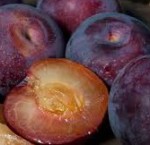 Santa Rosa Juicy, tangy and flavorful. Reddish purple skin with amber flesh tinged red. Self pollinating.
Santa Rosa Juicy, tangy and flavorful. Reddish purple skin with amber flesh tinged red. Self pollinating.
 Satsuma Mottled maroon over green skin with dark red meaty flesh. Sweet and mild, not tart. Excellent for jam.
Satsuma Mottled maroon over green skin with dark red meaty flesh. Sweet and mild, not tart. Excellent for jam.
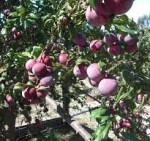 Weeping Santa Rosa One of the most flavorful, aromatic Japanese plums when fully ripe. Weeping growth habit. Can easily be espaliered. Self pollinating.
Weeping Santa Rosa One of the most flavorful, aromatic Japanese plums when fully ripe. Weeping growth habit. Can easily be espaliered. Self pollinating.
 Candy Heart Pluerry Japanese plum and sweet cherry cross. Taste-test proven treat. Its skin is dark speckled red, the amber/red flesh slightly subacid and very sweet, with a wonderfully unique flavor. This variety has an extended hang time, reaching peak ripeness around mid August. Pollinate with Santa Rosa or Burgundy plum.
Candy Heart Pluerry Japanese plum and sweet cherry cross. Taste-test proven treat. Its skin is dark speckled red, the amber/red flesh slightly subacid and very sweet, with a wonderfully unique flavor. This variety has an extended hang time, reaching peak ripeness around mid August. Pollinate with Santa Rosa or Burgundy plum.
 Dapple Dandy Pluot Often rated as one of the best tasing fruit. Creamy white and red fleshed freestone fruit with wonderful apricot plum flavor. Polinate with Santa Rosa plum.
Dapple Dandy Pluot Often rated as one of the best tasing fruit. Creamy white and red fleshed freestone fruit with wonderful apricot plum flavor. Polinate with Santa Rosa plum.
POMEGRANATES
(Available at Animas Creek Nursery or special order only)
 Parfianka Vigorous upright growth. Hardy variety with consistent heavy yields. Often rated as the best tasting pomegranate. Hardy in zones 7 to 9
Parfianka Vigorous upright growth. Hardy variety with consistent heavy yields. Often rated as the best tasting pomegranate. Hardy in zones 7 to 9
FIG
 Brown Turkey Large, brown skined with pink flesh. Rich sweet flavor. Good for fresh eating. Self pollinating. Hardy in zones 7 to 9. Must be brought indoors for the winter in Santa Fe.
Brown Turkey Large, brown skined with pink flesh. Rich sweet flavor. Good for fresh eating. Self pollinating. Hardy in zones 7 to 9. Must be brought indoors for the winter in Santa Fe.
 Texas Everbearing Medium to very large fruit. Also known as the English Brown Turkey Fig. Mahogany to purple skin with bright amber flesh. High quality fruit with excellent flavor. Spring and summer crops. Hardy in zones 7 to 9. Must be brought indoors for the winter in Santa Fe.
Texas Everbearing Medium to very large fruit. Also known as the English Brown Turkey Fig. Mahogany to purple skin with bright amber flesh. High quality fruit with excellent flavor. Spring and summer crops. Hardy in zones 7 to 9. Must be brought indoors for the winter in Santa Fe.
 Desert King yellowish-green figs have a sweet, strawberry-colored center and they are larger than most other figs (about the size of an extra-large egg). This variety does well in areas with cool nights. Hardy in zones 7 to 9. Must be brought indoors for the winter in Santa Fe.
Desert King yellowish-green figs have a sweet, strawberry-colored center and they are larger than most other figs (about the size of an extra-large egg). This variety does well in areas with cool nights. Hardy in zones 7 to 9. Must be brought indoors for the winter in Santa Fe.
 Peter’s Honey Greenish yellow, shiny fruit with amber flesh. Excellent fresh eating fig. Exceptionally cold hardy fig. Hardy in zones 6 to 9. Must be planted in a very protected area such as a courtyard and mulched very heavily during winter months.
Peter’s Honey Greenish yellow, shiny fruit with amber flesh. Excellent fresh eating fig. Exceptionally cold hardy fig. Hardy in zones 6 to 9. Must be planted in a very protected area such as a courtyard and mulched very heavily during winter months.
JUJUBE
 Li Also known as a Chinese Date. Round shaped fruits are larger than Lang. Reddish brown, dry and wrinkled, sweet and chewy (like dates) when fully ripe in early fall. Attractive, easy to grow tree: hardy, drought resistant, virtually pest and disease free. Requires long, hot summer. Very low chilling requirement. Hardy in zones 5 to 8
Li Also known as a Chinese Date. Round shaped fruits are larger than Lang. Reddish brown, dry and wrinkled, sweet and chewy (like dates) when fully ripe in early fall. Attractive, easy to grow tree: hardy, drought resistant, virtually pest and disease free. Requires long, hot summer. Very low chilling requirement. Hardy in zones 5 to 8
NUT TREES
ALMOND
 Non Pariel Sets the industry quality standard and commands top position in the market. Regular to heavy bearer, knocks well, easy to harvest. Pollinate with Texas Mission Almond Hardy in zones 5 to 8
Non Pariel Sets the industry quality standard and commands top position in the market. Regular to heavy bearer, knocks well, easy to harvest. Pollinate with Texas Mission Almond Hardy in zones 5 to 8
 Texas Mission The small-to-medium sized tree with a spreading, open canopy usually grows 10-15 ft. It has a showy white bloom which produces a wonderfully sweet nut. The Texas Mission is semi-self fertile and pollinates best with the Nonpareil. Hardy in zones 5 to 8
Texas Mission The small-to-medium sized tree with a spreading, open canopy usually grows 10-15 ft. It has a showy white bloom which produces a wonderfully sweet nut. The Texas Mission is semi-self fertile and pollinates best with the Nonpareil. Hardy in zones 5 to 8
WALNUT
 Native Black Walnut Large native tree that can grow in excess of 50′ tall. Nuts are great for baking and fresh eating. Hardy in zones 4 to 7
Native Black Walnut Large native tree that can grow in excess of 50′ tall. Nuts are great for baking and fresh eating. Hardy in zones 4 to 7
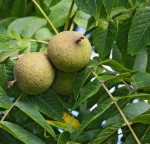 Pedro Very small tree, less than 2/3 the size of other varieties. Well-sealed nut, similar to Payne, has perhaps the finest-flavored kernel – winner of consumer taste tests. Widely adapted, excellent choice for home planting. Self fruitful.
Pedro Very small tree, less than 2/3 the size of other varieties. Well-sealed nut, similar to Payne, has perhaps the finest-flavored kernel – winner of consumer taste tests. Widely adapted, excellent choice for home planting. Self fruitful.
PECAN (available at Animas Creek Nursery only)
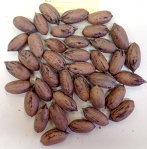 Western Schley Easy to grow, hardy tree. Less fussy about soil and nutrition. Long, tapered, medium-sized, thin-shelled nuts. Fine quality, midseason. 250 hours. Self-fruitful Hardy in zones 7 to 9
Western Schley Easy to grow, hardy tree. Less fussy about soil and nutrition. Long, tapered, medium-sized, thin-shelled nuts. Fine quality, midseason. 250 hours. Self-fruitful Hardy in zones 7 to 9
PISTACHIO (available at Animas Creek Nursery only)
 Kerman Long hot summers required to ripen. Plant from containers only, do not disturb root ball when handling. Very slow-growing to 20-30 ft. Drought-resistant. 800 hours. Pollenized by Peters. Hardy in zones 7 to 9
Kerman Long hot summers required to ripen. Plant from containers only, do not disturb root ball when handling. Very slow-growing to 20-30 ft. Drought-resistant. 800 hours. Pollenized by Peters. Hardy in zones 7 to 9
 Peters Pollenizer for Kerman. Does not bear fruit. One Peters pollenizes up to eleven females. Plant from containers only. Drought-resistant once established.
Peters Pollenizer for Kerman. Does not bear fruit. One Peters pollenizes up to eleven females. Plant from containers only. Drought-resistant once established.
GRAPES
 Concord Blue Versatile, long-time favorite American grape. Blue-black berry with rich, distinctive flavor, used for table, juice, jelly and wine. Cane prune. Very Hardy
Concord Blue Versatile, long-time favorite American grape. Blue-black berry with rich, distinctive flavor, used for table, juice, jelly and wine. Cane prune. Very Hardy
 Steuben Blue Heirloom grape first introduced in 1925. Steuben produces elongated clusters of medium-sized berries that taper at the end. The variety is particularly cold-hardy, vigorous and productive as well as being quite disease-resistant. Good for fresh eating and making wine. Hardy in zones 5 to 8
Steuben Blue Heirloom grape first introduced in 1925. Steuben produces elongated clusters of medium-sized berries that taper at the end. The variety is particularly cold-hardy, vigorous and productive as well as being quite disease-resistant. Good for fresh eating and making wine. Hardy in zones 5 to 8
 Suffolk Red Seedless red grape. The Suffolk Red seedless grape vine ripens in August and September and is cold hardy enough to survive in minus 10 degrees F temperatures. Outstanding mild grape flavor. Hardy in zones 5 to 8
Suffolk Red Seedless red grape. The Suffolk Red seedless grape vine ripens in August and September and is cold hardy enough to survive in minus 10 degrees F temperatures. Outstanding mild grape flavor. Hardy in zones 5 to 8
 Vanessa Red Red seedless grape. The vines of Vanessa are moderately vigorous and among the hardiest of seedless grapes. Excellent, delicious table grapes. The fruit has a blushing-red skin, the firm yet tender flesh melts smoothly to release the fruity flavor. Also perfect for grape pies, jams or jellies. Considered to be one of the best tasting red seedless grapes. Hardy in zones 4 to 7
Vanessa Red Red seedless grape. The vines of Vanessa are moderately vigorous and among the hardiest of seedless grapes. Excellent, delicious table grapes. The fruit has a blushing-red skin, the firm yet tender flesh melts smoothly to release the fruity flavor. Also perfect for grape pies, jams or jellies. Considered to be one of the best tasting red seedless grapes. Hardy in zones 4 to 7

Niagara White Heirloom grape introduced in the 1860’s. White seeded grape. Excellent flavor and aroma. Hardy in zones 5 to 8

Remaily Seedless Medium large seedless grapes with crisp sweet flavor. Vigorous vines cane be grown as a large vine on a fence or cane pruned. Disease resistant. Hardy in zones 5 to 8
 Glenora Black Seedless One of the most cold hardy grapes, hardy to minus 15 degrees Fahrenheit. Vines yield huge clusters of juicy, medium to large grapes with deep, blue-black color. One of the best grapes for raisers. Zones 4 to 8
Glenora Black Seedless One of the most cold hardy grapes, hardy to minus 15 degrees Fahrenheit. Vines yield huge clusters of juicy, medium to large grapes with deep, blue-black color. One of the best grapes for raisers. Zones 4 to 8
BERRIES
RASPBERRIES
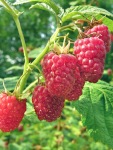 Latham Sweet firm raspberry. Best grown in full sun. Heavy yielding variety that is easy to grow. Fertilize spring and fall for best flavor and fruit production. Summer crop ripens in early July. Hardy in zones 3 to 6
Latham Sweet firm raspberry. Best grown in full sun. Heavy yielding variety that is easy to grow. Fertilize spring and fall for best flavor and fruit production. Summer crop ripens in early July. Hardy in zones 3 to 6
 Tulameen Very large sweet fruit. One of the best summer types. Tulameen can also be grown in large containers. Yearly prune in the early spring for best harvests and fertilize twice a year, spring and fall. Hardy in zones 3 to 6
Tulameen Very large sweet fruit. One of the best summer types. Tulameen can also be grown in large containers. Yearly prune in the early spring for best harvests and fertilize twice a year, spring and fall. Hardy in zones 3 to 6
 Amity Ever bearing Variety – Large, firm, dark red berries with classic raspberry flavor and superior quality. Resistant to Root Rot and aphids and can take somewhat heavier clay soils. Tolerates heat better than other raspberries. Prune all canes early spring to 8 inches. Hardy zones 4 to 6.
Amity Ever bearing Variety – Large, firm, dark red berries with classic raspberry flavor and superior quality. Resistant to Root Rot and aphids and can take somewhat heavier clay soils. Tolerates heat better than other raspberries. Prune all canes early spring to 8 inches. Hardy zones 4 to 6.
 Fall Gold Ever Bearing Variety producing a crop early summer and mid fall. Sweet mild raspberry flavor. Excellent fresh or for preserves and pies. Prune all canes early spring to 8 inches. Hardy zones 4 to 6.
Fall Gold Ever Bearing Variety producing a crop early summer and mid fall. Sweet mild raspberry flavor. Excellent fresh or for preserves and pies. Prune all canes early spring to 8 inches. Hardy zones 4 to 6.
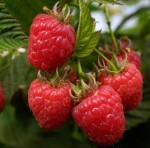 Heritage Ever Bearing Variety producing a crop early summer and mid fall. This variety produces abundant crops of large, sweet, dark red berries that are perfect for fresh eating, canning or making jam. Self-supporting, upright canes should be planted 4 feet apart. Prune all canes early spring to 8 inches. Hardy zones 3 to 6.
Heritage Ever Bearing Variety producing a crop early summer and mid fall. This variety produces abundant crops of large, sweet, dark red berries that are perfect for fresh eating, canning or making jam. Self-supporting, upright canes should be planted 4 feet apart. Prune all canes early spring to 8 inches. Hardy zones 3 to 6.
 Caroline Red raspberry with superior flavor. Vigorous vine with large fall crop and a medium to small early summer crop. Huge fruit with tart sweet classic raspberry flavor. Self-supporting, upright canes should be planted 4 feet apart. Prune all canes early spring to 8 inches. Hardy zones 3 to 6.
Caroline Red raspberry with superior flavor. Vigorous vine with large fall crop and a medium to small early summer crop. Huge fruit with tart sweet classic raspberry flavor. Self-supporting, upright canes should be planted 4 feet apart. Prune all canes early spring to 8 inches. Hardy zones 3 to 6.
 Baba One of the largest raspberries, the Baba Raspberry is red, sweet, firm, and has an excellent flavor. This berry is great for hot areas . It bears large crops in early Summer and a small crop in the fall. Self-supporting, upright canes should be planted 4 feet apart. Prune all canes early spring to 8 inches. Hardy zones 5 to 7.
Baba One of the largest raspberries, the Baba Raspberry is red, sweet, firm, and has an excellent flavor. This berry is great for hot areas . It bears large crops in early Summer and a small crop in the fall. Self-supporting, upright canes should be planted 4 feet apart. Prune all canes early spring to 8 inches. Hardy zones 5 to 7.
STRAWBERRIES
 Eversweet Everbearing Sets a big crop early in the summer season, then continues to bear smaller crops each 6 weeks until early fall. Tolerates heat better than other strawberry types. Best strawberry for the Southwest. Medium to larger berries with sweet strawberry flavor. Great for growing in containers or in the ground. Hardy zones 5 to 7
Eversweet Everbearing Sets a big crop early in the summer season, then continues to bear smaller crops each 6 weeks until early fall. Tolerates heat better than other strawberry types. Best strawberry for the Southwest. Medium to larger berries with sweet strawberry flavor. Great for growing in containers or in the ground. Hardy zones 5 to 7
GOOSEBERRIES
 Black Velvet The deep purple fruits are the size of seedless grapes. They are very vigorous in growth. Excellent flavor . Black Velvet has won awards for its superb qualities and disease and mildew resistance. plant on 4′ to 5′ centers. Zones 4-7.
Black Velvet The deep purple fruits are the size of seedless grapes. They are very vigorous in growth. Excellent flavor . Black Velvet has won awards for its superb qualities and disease and mildew resistance. plant on 4′ to 5′ centers. Zones 4-7.
ELDERBERRIES
 Nova An easy-care addition to the edible landscape. Wide clusters of creamy white flowers appear in spring. If left on the bush, the flowers develop into bountiful bunches of tender, deep purple berries used in jams, pies, and wines. Native to North America, these fast-growing bushes attract bees and hummingbirds. Ripens in early August. In spring, these plants feature lovely white blooms, and in summer, they produce a bounty of soft, dark purple berries that are good for cooking or making delicious jams, jellies and wines rich in vitamin C. Berries ripen later than counterpart: Nova. Easy-to-grow plants tolerate dry or moist soils once established. Fruit is not affected by growing in partial shade. Pollinate with York Elderberry Hardy in zones 4 to 8
Nova An easy-care addition to the edible landscape. Wide clusters of creamy white flowers appear in spring. If left on the bush, the flowers develop into bountiful bunches of tender, deep purple berries used in jams, pies, and wines. Native to North America, these fast-growing bushes attract bees and hummingbirds. Ripens in early August. In spring, these plants feature lovely white blooms, and in summer, they produce a bounty of soft, dark purple berries that are good for cooking or making delicious jams, jellies and wines rich in vitamin C. Berries ripen later than counterpart: Nova. Easy-to-grow plants tolerate dry or moist soils once established. Fruit is not affected by growing in partial shade. Pollinate with York Elderberry Hardy in zones 4 to 8
 York Large clusters of white flowers in spring followed by dark purple berries in late summer that are good for cooking or making delicious jams and wines rich in vitamin C. Berries ripen later than counterpart: Nova. Easy-to-grow plants tolerate dry or moist soils once established. Fruit is not affected by growing in partial shade. Pollinate with York Elderberry Hardy in zones 4 to 8
York Large clusters of white flowers in spring followed by dark purple berries in late summer that are good for cooking or making delicious jams and wines rich in vitamin C. Berries ripen later than counterpart: Nova. Easy-to-grow plants tolerate dry or moist soils once established. Fruit is not affected by growing in partial shade. Pollinate with York Elderberry Hardy in zones 4 to 8
CURRANTS
 Cherry Red The berries are very large, bright dark red, acidic with good flavor that is great for cooking and making jellies. Plants are vigorous, upright and productive. Cherry Red resists mildew. Grow in half day sun to dappled sun. Drought tolerant once established. Good plant for pollinators. Hardy in zones 3 to 7
Cherry Red The berries are very large, bright dark red, acidic with good flavor that is great for cooking and making jellies. Plants are vigorous, upright and productive. Cherry Red resists mildew. Grow in half day sun to dappled sun. Drought tolerant once established. Good plant for pollinators. Hardy in zones 3 to 7
 Crandall Black Heirloom fruiting currant with dark black berries for cooking and making jellies. Grows 4′ tall and wide. Tolerates shade and drought. Blooms late spring with fragrant yellow flowers. Good red fall foliage color. Hardy in zones 4 to 7
Crandall Black Heirloom fruiting currant with dark black berries for cooking and making jellies. Grows 4′ tall and wide. Tolerates shade and drought. Blooms late spring with fragrant yellow flowers. Good red fall foliage color. Hardy in zones 4 to 7
MULBERRY
 Dwarf Black Easy-to-grow, this abundant producer of sweet medium-sized fruit has performed exceptionally well in pots yielding several crops per year even during the first season. Exceptional for attracting birds. Hardy in zones 5 to 9
Dwarf Black Easy-to-grow, this abundant producer of sweet medium-sized fruit has performed exceptionally well in pots yielding several crops per year even during the first season. Exceptional for attracting birds. Hardy in zones 5 to 9
GOJI BERRY

Goji berry plants grow as long, rambling canes. Goji naturally wants to run along the ground, so staking or a trellis will save space and protect your fruit. Cold hardy plants that thrive in our alkaline soils. Easy to grow. Hardy in zones 4 to 7
